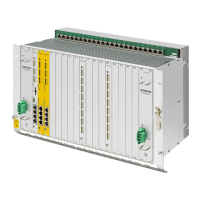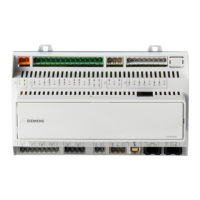Detailed Description
2.8 Help function output to PLC (H2)
Basic logic functions: NC/PLC interface signals (Z1)
Function Manual, 11/2006, 6FC5397-0BP10-2BA0
75
DB21, ...
DBX59.0 - DBX59.4
M function 1-5 not included in list
Edge evaluation: no Signal(s) updated: Jobcontrolled by NCK
Signal state 1 or
edge change
0 → 1
M function is greater than 99 (for extended address = 0) or for extended address > 0, not included
in the decoding list.
This signal is available - together with the associated M change signal - for one OB1 cycle.
Cause:
• Incorrect M function programmed
• M function not configured in the decoding list of the PLC
Remedy, e.g.:
• PLC sets read-in disable
• Output of a PLC alarm
Signal state 0 or
edge change
1 → 0
M function less than 99 (for extended address = 0) or for extended address > 0 included in the
decoding list.
DB21, ...
DBB60 - DBB64,
DBB66 - DBB67
M, S, T, D, H, F functions Additional info "Quick" (fast acknowledgment)
Edge evaluation: no Signal(s) updated: Jobcontrolled by NCK
Signal state 1 or
edge change
0 → 1
One M, S, T, An D, H, or F function has been output to the interface with a new value together with
the associated change signal at the beginning of an OB1 cycle.
In this case, the additional info "Quick" indicates the quick help function.
Signal state 0 or
edge change
1 → 0
The change signals are reset by the PLC basic program at the start of the next OB1 cycle.
The value of the data involved is not valid.
DB21, ...
DBB68 - DBB97
M functions 1 to 5
Extended address M functions 1 to 5
Edge evaluation: no Signal(s) updated: Jobcontrolled by NCK
Signal state 1 or
edge change
0 → 1
Up to 5 M functions programmed in an NC block are simultaneously made available here as soon
as the M change signals are available.
Value range of M functions: 0 to 9999 9999; integer number
Value range of the extended address: 0 to 99; integer number
The M functions remain valid until they are overwritten by new M functions.
Signal state 0 or
edge change
1 → 0
• After PLC power-up.
• All help functions are deleted before a new function is entered.
Application
example(s)
Decoding and evaluation of M functions that are not decoded as standard or via a list.
Using the extended address, the M function can be assigned to another channel that does not
correspond to that channel in which the program is running.
Special cases,
errors, ......
For M00 to M99 the extended address = 0.

